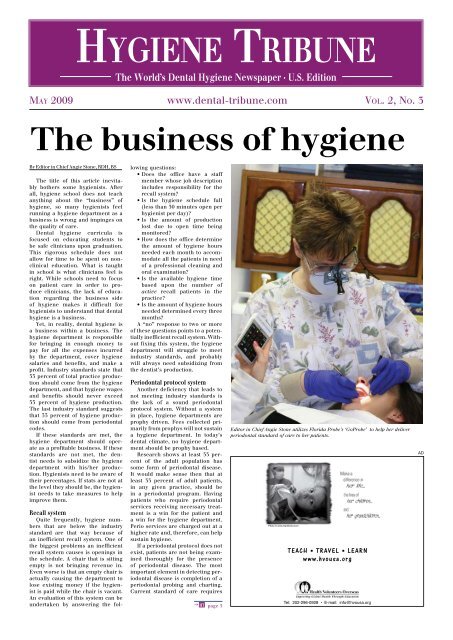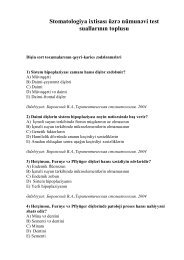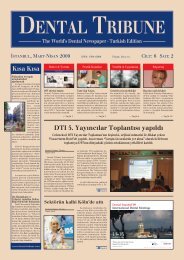DENTAL TRIBUNE
DENTAL TRIBUNE
DENTAL TRIBUNE
Create successful ePaper yourself
Turn your PDF publications into a flip-book with our unique Google optimized e-Paper software.
HYGIENE <strong>TRIBUNE</strong><br />
The World’s Dental Hygiene Newspaper · U.S. Edition<br />
MAY 2009 www.dental-tribune.com VOL. 2, NO. 3<br />
The business of hygiene<br />
By Editor in Chief Angie Stone, RDH, BS<br />
The title of this article inevitably<br />
bothers some hygienists. After<br />
all, hygiene school does not teach<br />
anything about the “business” of<br />
hygiene, so many hygienists feel<br />
running a hygiene department as a<br />
business is wrong and impinges on<br />
the quality of care.<br />
Dental hygiene curricula is<br />
focused on educating students to<br />
be safe clinicians upon graduation.<br />
This rigorous schedule does not<br />
allow for time to be spent on nonclinical<br />
education. What is taught<br />
in school is what clinicians feel is<br />
right. While schools need to focus<br />
on patient care in order to produce<br />
clinicians, the lack of education<br />
regarding the business side<br />
of hygiene makes it difficult for<br />
hygienists to understand that dental<br />
hygiene is a business.<br />
Yet, in reality, dental hygiene is<br />
a business within a business. The<br />
hygiene department is responsible<br />
for bringing in enough money to<br />
pay for all the expenses incurred<br />
by the department, cover hygiene<br />
salaries and benefits, and make a<br />
profit. Industry standards state that<br />
33 percent of total practice production<br />
should come from the hygiene<br />
department, and that hygiene wages<br />
and benefits should never exceed<br />
33 percent of hygiene production.<br />
The last industry standard suggests<br />
that 33 percent of hygiene production<br />
should come from periodontal<br />
codes.<br />
If these standards are met, the<br />
hygiene department should operate<br />
as a profitable business. If these<br />
standards are not met, the dentist<br />
needs to subsidize the hygiene<br />
department with his/her production.<br />
Hygienists need to be aware of<br />
their percentages. If stats are not at<br />
the level they should be, the hygienist<br />
needs to take measures to help<br />
improve them.<br />
Recall system<br />
Quite frequently, hygiene numbers<br />
that are below the industry<br />
standard are that way because of<br />
an inefficient recall system. One of<br />
the biggest problems an inefficient<br />
recall system causes is openings in<br />
the schedule. A chair that is sitting<br />
empty is not bringing revenue in.<br />
Even worse is that an empty chair is<br />
actually causing the department to<br />
lose existing money if the hygienist<br />
is paid while the chair is vacant.<br />
An evaluation of this system can be<br />
undertaken by answering the fol-<br />
lowing questions:<br />
�������� ���� ������ ����� �� ������<br />
member whose job description<br />
includes responsibility for the<br />
recall system?<br />
������ ���� �������� ��������� �����<br />
(less than 30 minutes open per<br />
hygienist per day)?<br />
������ ���� ������� ��� �����������<br />
lost due to open time being<br />
monitored?<br />
��������������������������������<br />
the amount of hygiene hours<br />
needed each month to accommodate<br />
all the patients in need<br />
of a professional cleaning and<br />
oral examination?<br />
������ ���� ���������� �������� �����<br />
based upon the number of<br />
active recall patients in the<br />
practice?<br />
����������������������������������<br />
needed determined every three<br />
months?<br />
A “no” response to two or more<br />
of these questions points to a potentially<br />
inefficient recall system. Without<br />
fixing this system, the hygiene<br />
department will struggle to meet<br />
industry standards, and probably<br />
will always need subsidizing from<br />
the dentist’s production.<br />
Periodontal protocol system<br />
Another deficiency that leads to<br />
not meeting industry standards is<br />
the lack of a sound periodontal<br />
protocol system. Without a system<br />
in place, hygiene departments are<br />
prophy driven. Fees collected primarily<br />
from prophys will not sustain<br />
a hygiene department. In today’s<br />
dental climate, no hygiene department<br />
should be prophy based.<br />
Research shows at least 33 percent<br />
of the adult population has<br />
some form of periodontal disease.<br />
It would make sense then that at<br />
least 33 percent of adult patients,<br />
in any given practice, should be<br />
in a periodontal program. Having<br />
patients who require periodontal<br />
services receiving necessary treatment<br />
is a win for the patient and<br />
a win for the hygiene department.<br />
Perio services are charged out at a<br />
higher rate and, therefore, can help<br />
sustain hygiene.<br />
If a periodontal protocol does not<br />
exist, patients are not being examined<br />
thoroughly for the presence<br />
of periodontal disease. The most<br />
important element in detecting periodontal<br />
disease is completion of a<br />
periodontal probing and charting.<br />
Current standard of care requires<br />
� HT page 3<br />
Editor in Chief Angie Stone utilizes Florida Probe’s ‘GoProbe’ to help her deliver<br />
periodontal standard of care to her patients.<br />
����� � �����������������<br />
����� �<br />
� ������ �����<br />
��������������<br />
���� ������������ � ������� ���������������<br />
AD




